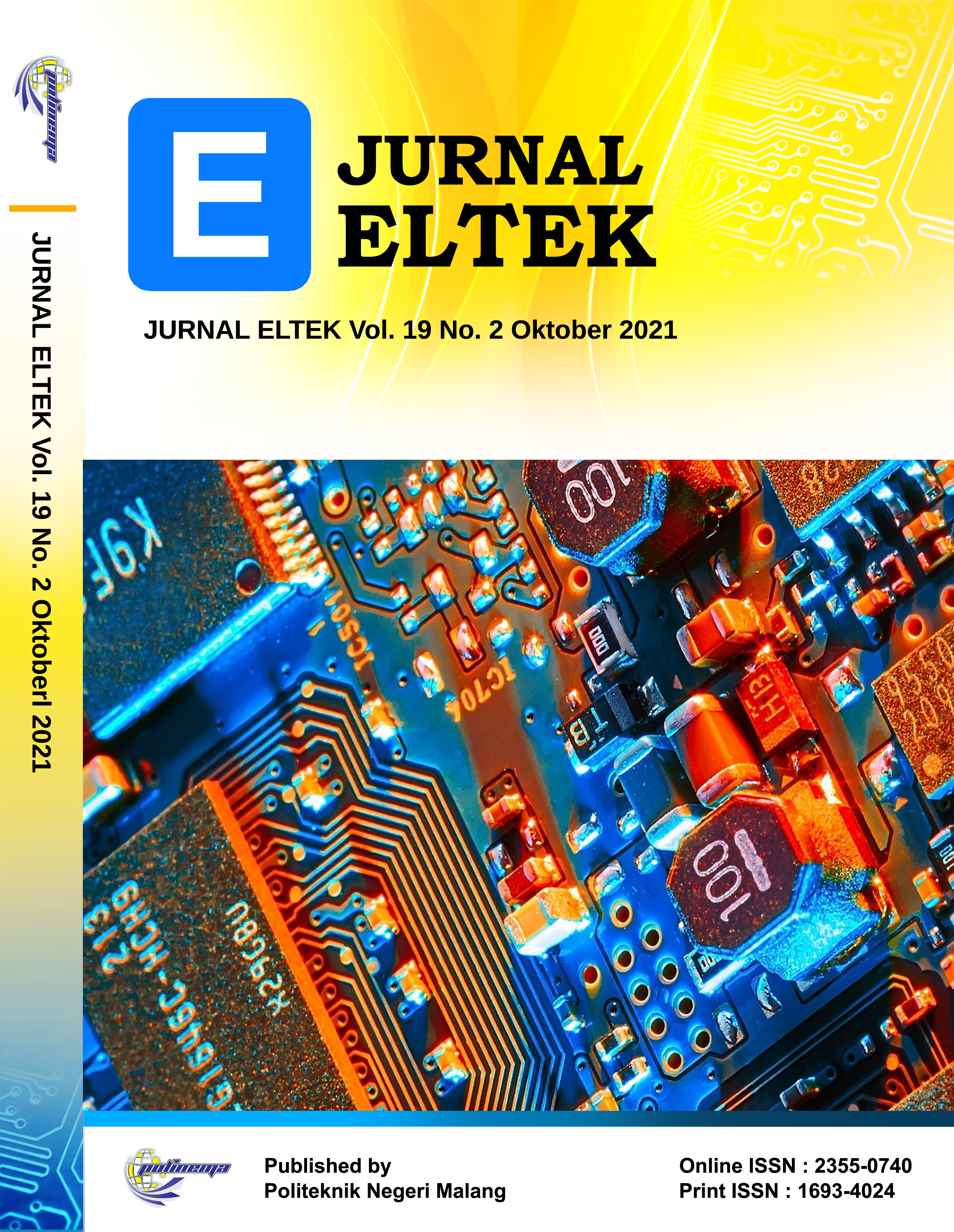Telemonitoring alat fisioterapi pasien pasca stroke berbasis Internet of Things (IoT)
DOI:
https://doi.org/10.33795/eltek.v19i2.281Keywords:
Stroke, Fisioterapi, Mikrokontroller, MPU6050Abstract
Stroke Transient Ischemic Attack (TIA) adalah kondisi stroke ringan yang dapat disebabkan oleh berkurangnya suplai darah menuju otak diakibatkan pembuluh darah tersumbat. Kurangnya aliran darah ke otak dapat menyebabkan kelumpuhan, biasanya hanya pada satu sisi tubuh seperti pada siku dan lutut. Fisioterapi pada pasien pasca stroke ringan dilakukan dengan metode terapi gerakan antara lain yaitu elbow dan knee flexion. Saat ini pasien datang ke terapis atau sebaliknya untuk melakukan gerakan terapi, sehingga dibuatlah sebuah sistem telemonitoring alat fisoterapi pasien pasca stroke menggunakan sensor MPU6050 yang terhubung ESP 232 dan jaringan internet serta dapat dimonitoring oleh terapis dan admin klinik tempat terapinya. Sistem ini membantu monitoring latihan gerakan elbow dan knew flexion menggunakan sensor MPU6050 yang digunakan untuk mendeteksi sudut serta banyaknya gerakan rehabilitasi pasien pasca stroke. Dari hasil pengujian akurasi sensor ini mampu mendeteksi sudut gerakan elbow dari 00-1500 dan sudut knee flexion 00-1350 sebesar 99%. Aplikasi telemonitoring alat fisioterapi pasien pasca stroke berbasis android ini dilengkapi dengan menu terapis sehingga jumlah gerakan dan rata-rata sudut gerakan lutut maupun siku dapat dimonitoring oleh terapis, alat ini juga dapat digunakan dimana dan kapan saja dikarenakan bentuk alat ini yang portable.
ABSTRACT
Stroke Transient Ischemic Attack (TIA) is a mild stroke condition that can be caused by reduced blood supply to the brain due to blocked blood vessels. Lack of blood flow to the brain can cause paralysis, usually only on one side of the body such as the elbows and knees. Physiotherapy in post-stroke patients is carried out using movement therapy methods, including elbow and knee flexion. Currently, patients come to the therapist or vice versa to perform therapeutic movements, so a telemonitoring system for post-stroke patient physiotherapy tools is made using the MPU6050 sensor which is connected to ESP 232 and the internet network and can be monitored by therapists and clinic admins where the therapy is done. This system helps monitor elbow and knew flexion exercises using the MPU6050 sensor which is used to detect the angle and number of rehabilitation movements of poststroke patients. . From the results of testing the accuracy of this sensor is able to detect the angle of elbow movement from 00-1500 and knee flexion angle of 00-1350 by 99%.The telemonitoring application for physiotherapy tools for post-stroke patients based on Android is equipped with a therapist menu so that the number of movements and the average angle of movement of the knees and elbows can be monitored by the therapist, this tool can also be used anywhere and anytime due to the portable form of this tool.
References
Fitra, Syahrul ,”Desain dan Manufaktur Robot Rehabilitasi Lutut untuk Pasien Pasca Stroke”, Jurusan Teknik
Mesin dan Industri, Universitas Gadjah Mada, Yogyakarta, 2016.
Yastroki,”Angka kejadian stroke meningkat tajam” 2009. [Online]. Available: http://www.yastroki.or.id/read.php?id=317. (online accessed: 25 Januari 2020)
Harsono, “Buku Ajar Neurologi Klinis”, Yogyakarta: Penerbit Gadjah Mada Press,1996.
Perkasa Teguh,Rachmat, Hendi, “Perancangan Alat Ukur Sudut Tekuk Lutut Wireless Menggunakan Sensor Gyroscope berbasis ATMega 328 dan ATMega 2560”, Jurusan Teknik Elektro, Institut Teknologi Nasional, Yogyakarta,2017.
Sadewo, Angger, dkk., “Perancangan Pengendalian Rumah Menggunakan Smartphone Android dengan Konektivitas Bluetooth”. Jurnal Pengembangan Teknologi Informasi dan Ilmu Komputer (hlm 415-425), 2017.
Fadillah Siti, Lanni Fransiska dan Tri Purnomo Romadhoni, “Analisis Faktor yang Berhubungan dengan Kepatuhan Fisioterapi Pasien Pasca Stroke di RS Bethesda Yogyakarta”.Jurnal Ilmu Kesehatan, Yogyakarta, 2 Desember 2019.
Tim Muskuloskeletal & PPDS Program Studi I Kedokteran Fisik dan Rehabilitasi FK UNAIR & RSUD Dr. Soetomo . 2019. Surabaya
Core, “Wiring the MPU 6050 Sensor Mems Accelerometer GYRO”, 2020. [Online]. Available: https://www.14core.com/wp-content/uploads/2016/04/Gyro-Board-MPU-6050-Arduino-Sensor.jpg. [Online Accessed :6 Maret 202].
Seeed Technology Co, “Arduino Nano v3”, 2020. [Online]. Available: https://staticcdn.seeedstudio.site/media/catalog/product/cache/9d0ce51a71ce6a79dfa2a98d65a0f0bd/h/t/httpsstatics3.seeedstudio.comimagesproductarduino20nano.jpg.[Online Accessed :6 Maret 2020].
Downloads
Published
How to Cite
Issue
Section
License
Copyright (c) 2021 Lis Diana Mustafa, Azam Muzakhim Imamuddin, Yoyok Isnomo

This work is licensed under a Creative Commons Attribution-ShareAlike 4.0 International License.







